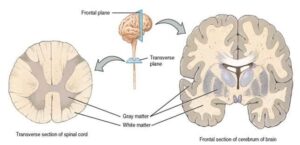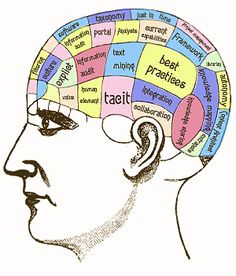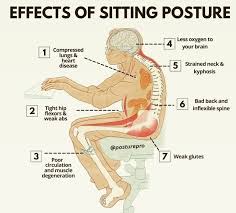

I find it really awkward when someone asks me, “how nerd neck affects your grey matter?”
Do you know the reason why???
Well, this question often makes me wonder if my forward neck posture is so damn obvious to others.
The “silly” 3 inch forward slide of my head (which I thought was normal) is so very visible to even a stranger.
It is sad indeed as my text neck gave me brain fatigue and I was not even aware of it – until it was too late!
Nonetheless, after I looked at my profile in the mirror, I realized how true everyone was about my bad neck posture.
So while trying to fix my bad neck posture, I did some serious research on how and why people like me develop a vulture neck posture.
Then, I went deeper and found the various links of having a forward head with my physical body.
I can also term this as adverse effects of having a bad neck posture.
Well, I found a link that connected my “grey matter” (the one present in my brain) with my forward head posture.
Let me walk you through with this in brief:
Article Index:
1) What is Grey Matter of the Human Brain?
2) What are the Main Functions of My Grey Matter?
3) How My Nerd Neck Impacted My Brain’s Grey Matter?
4) FAQs on Nerd Neck Posture & Your Grey Matter
4) My Final Thoughts
What is Grey Matter of the Human Brain?
Grey matter—the brain’s mysterious and slightly ominous-sounding component. But don’t let the name fool you. In reality, grey matter is anything but dull!
A Brainy Introduction
Grey matter, which makes up about 40% of the human brain, is named for its pinkish-grey color, thanks to the numerous cell bodies and capillaries it contains.
Think of it as the brain’s bustling metropolis, filled with neurons and glial cells going about their daily business.
The Neuronal Neighborhood
Located in regions such as the cerebral cortex, cerebellum, and brainstem, grey matter houses a high concentration of neuronal cell bodies, dendrites, and axon terminals.
These densely packed neurons create a vibrant network essential for processing information.
According to research by Fields (2008), grey matter is where most of the brain’s synaptic activity occurs, making it a hotspot for neuronal communication.
The Cellular Symphony
In addition to neurons, grey matter includes various types of glial cells—think of them as the support staff, keeping everything running smoothly.
Astrocytes, for example, maintain the blood-brain barrier, while oligodendrocytes insulate axons with myelin.
A study by Nedergaard et al. (2003) highlights the critical role of these glial cells in maintaining brain homeostasis.
The Ever-Changing Landscape
Interestingly, grey matter is not static. Its density can change with learning and experience, a phenomenon known as neuroplasticity. Draganski et al. (2004) found that acquiring new skills, like juggling, can increase grey matter volume in certain brain regions.
In short, grey matter is the brain’s dynamic hub, constantly adapting and evolving with every new experience.
So, the next time you think of your brain’s grey matter, remember it is not just a blob—it is a lively, ever-changing community, tirelessly working behind the scenes.
What are the Main Functions of My Grey Matter?
Grey Matter is undoubtedly the unsung hero of my brain.
If you have ever wondered what this mysterious substance does, let me take you on a witty and enlightening journey through my very own grey matter.
Processing Powerhouse
First off, grey matter is the ultimate processing powerhouse. Think of it as the brain’s central command center.
Whenever I am solving a complex puzzle or deciding which pizza toppings to order, it is my grey matter hard at work.
This is because grey matter contains most of the brain’s neuronal cell bodies, where all the magic happens.
As per the research study conducted by Fields (2008), grey matter is where the majority of synaptic activity takes place, making it essential for information processing.
Sensory Symphony
Ever marveled at how I (BestForwardHeadPostureFix research staff )can smell fresh coffee, taste delicious chocolate, or feel the soft fur of a cat?
That is my grey matter playing a crucial role in sensory perception. It is the conductor of this sensory symphony, processing inputs from all my senses.
According to Nedergaard et al. (2003), grey matter houses numerous glial cells and neurons that interpret sensory information, allowing me to experience the world in vivid detail.
Memory Maestro
Remembering my childhood friend’s birthday or the lyrics to my favorite song?
That’s grey matter’s doing. It’s heavily involved in memory formation and recall. When I learn something new or recall an old memory, it’s my grey matter firing up those neurons.
Draganski et al. (2004) found that learning new skills, like juggling, can actually increase the volume of grey matter, showcasing its role in neuroplasticity and memory.
Emotional Epicenter
Emotions? Yep, grey matter’s got that covered too.
Whether I’m feeling joy, sadness, or excitement, grey matter processes and regulates my emotional responses.
This emotional epicenter ensures I react appropriately to various situations, balancing logic with emotion.
In conclusion, my grey matter is a multi-talented superstar, handling everything from sensory perception and memory to emotion and complex thought processes.
My grey matter is constantly adapting, learning, and evolving, making it the true unsung hero of my brain.
So, next time you marvel at a clever thought or a vivid memory, give a nod to your grey matter—because it is working tirelessly to make it all happen.
How My Nerd Neck Impacted My Brain’s Grey Matter?
In my opinion, a nerd neck is a badge of honor for us tech enthusiasts and a thorn in the neck (literally!).
If you have ever caught yourself hunched over your laptop like Quasimodo with WiFi, you might wonder how this posture affects more than just your spine.
Let me tell you how my Nerd Neck tangled with my grey matter:
The Nerd Neck Chronicles
Paint this image if you can: countless hours slouched over cellphone screens, peering at tiny text, oblivious to the slow curve forming in my neck.
I thought my biggest concern was looking like a human question mark. Little did I know, this hunched posture was putting a damper on my brain’s performance.
The Blood Flow Blues
Turns out, Nerd Neck is not just a pain in the neck—it’s a buzzkill for brain function too.
As per a research study conducted by Louise D. Rietdyk, forward head posture can restrict blood flow to the brain.
With my head jutting forward, it is like pinching a garden hose, reducing the flow of oxygen-rich blood.
My grey matter, the brain’s powerhouse, was not getting the nutrients it needed to thrive.
Focus? Forget About It!
Ever felt like your brain was wrapped in fog after a marathon screen session?
That’s Nerd Neck messing with your cognitive clarity. A study by Michael T. Freeman found that poor posture can lead to cognitive decline and diminished focus.
My grey matter struggled to keep up, making it harder to remember why I walked into a room or follow complex plotlines on Netflix.
Mood Swings and Brain Drains
Believe it or not, Nerd Neck was also a culprit in my mood swings.
As per Nair et al., bad neck posture can heighten stress and anxiety.
My grey matter was busy processing negative emotions, leaving me feeling more like a grumpy cat than a curious kitten.
Straighten Up for Smarter Days
Realizing the impact, I decided to straighten up—literally.
I adjusted my workstation, embraced ergonomic solutions, and took regular breaks to stretch. It was like giving my grey matter a much-needed vacation.
Improved posture led to better blood flow, sharper focus, and a brighter mood.
Who knew sitting up straight could be so revolutionary?
In conclusion, Nerd Neck was a silent saboteur of my grey matter. But with a little adjustment, I’ve managed to give my brain the boost it deserves.
So, fellow screen junkies, let’s stand tall and keep our grey matter thriving!
FAQs on Nerd Neck Posture & Your Grey Matter
Q1: How does “nerd neck” impact cognitive functions?
A1: “Nerd neck,” or forward head posture, can cause cognitive fatigue. When the head is positioned forward, the brain’s ability to process sensory information decreases, leading to reduced focus, slower reaction times, and overall mental exhaustion during everyday tasks.
Q2: Is there a connection between neck posture and brain gray matter volume?
A2: Studies show that neck posture, particularly increased neck circumference linked to poor alignment, may correlate with reduced gray matter volume in the brain. Since gray matter is essential for information processing and muscle control, this reduction can affect cognitive and motor functions.
Q3: Can forward head posture affect balance and coordination?
A3: Forward head posture alters the body’s center of gravity, which can disrupt balance and coordination. This misalignment increases instability and the risk of falls, especially among older adults, potentially leading to serious injuries.
Q4: How does prolonged “nerd neck” influence neck and shoulder health?
A4: Maintaining a forward head posture over time places excessive strain on neck and shoulder muscles. This can result in chronic pain, stiffness, muscle imbalances, and a reduced range of motion, all of which negatively impact daily activities and comfort.
Q5: What are effective strategies to mitigate the effects of “nerd neck”?
A5: To combat “nerd neck,” it is important to maintain proper head and spine alignment. Taking regular breaks from screen time, setting up ergonomic workstations, and performing exercises to strengthen neck and upper back muscles can help relieve discomfort and prevent long-term damage.
My Final Thought
It is a well-known fact that forward head posture is not an ideal posture for your cervical neck. It does lay a lot of stress on your neck and upper back muscles.
This is a side effect (of bad neck posture) which almost every other person who suffers from a nerd neck knows and also acknowledges.
Nonetheless, the impact of forward neck is not merely limited to what we can see, feel and experience. One such example is: the impact of a forward head on your cervical spine.
I shall continue to add such topics into my discussion so as to spread awareness on the importance of correct posture in your life.
References:


